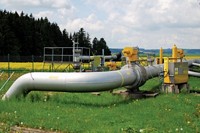Advertisement
Grab your lab coat. Let's get started
Welcome!
Welcome!
Create an account below to get 6 C&EN articles per month, receive newsletters and more - all free.
It seems this is your first time logging in online. Please enter the following information to continue.
As an ACS member you automatically get access to this site. All we need is few more details to create your reading experience.
Not you? Sign in with a different account.
Not you? Sign in with a different account.
ERROR 1
ERROR 1
ERROR 2
ERROR 2
ERROR 2
ERROR 2
ERROR 2
Password and Confirm password must match.
If you have an ACS member number, please enter it here so we can link this account to your membership. (optional)
ERROR 2
ACS values your privacy. By submitting your information, you are gaining access to C&EN and subscribing to our weekly newsletter. We use the information you provide to make your reading experience better, and we will never sell your data to third party members.
Environment
Septic Tanks Produce Less Greenhouse Gases Than Expected
Climate Change: Researchers measure gases produced by tank microbes
by Valerie Brown
March 16, 2011

Around one-fifth of the U.S. population uses septic tanks to treat wastewater from their homes. Because the microorganisms that break down the tanks' waste produce greenhouse gases including methane, carbon dioxide, and nitrous oxide, knowing the magnitude of tank emissions is critical to accurately model the climate. Now researchers report empirical measurements of septic tank emissions and show that they're about half as high as estimates (Environ. Sci. Technol., DOI: 10.1021/es1036095).
Currently climate modelers estimate septic tank emissions based on the rate at which microbes convert organic matter into methane. The Intergovernmental Panel on Climate Change (IPCC) estimates that an average tank emits 0.23 metric tons of carbon dioxide equivalents per tank user per year.
To make measurements, environmental engineer Chris Cappa of the University of California, Davis, and his colleagues collected samples from eight domestic septic systems in California. They quantified gas levels from different parts of the septic systems using gas chromatography and calculated that a septic tank emits on average 11 g of methane per user per day. By contrast, IPCC estimates that a tank emits 25.5 g of methane per user per day. Meanwhile, Cappa found that CO2 emissions averaged 33.3 g per user per day, and N2O emissions were negligible. Overall, the team reported that septic tanks produce between 0.1 and 0.12 metric tons of carbon dioxide equivalents per user per year.
Typically, methane production is temperature sensitive, but temperatures inside the tanks didn't seem to influence emissions, Cappa says. This consistency suggests that their results should be robust over a wide range of climates, he says.





Join the conversation
Contact the reporter
Submit a Letter to the Editor for publication
Engage with us on Twitter